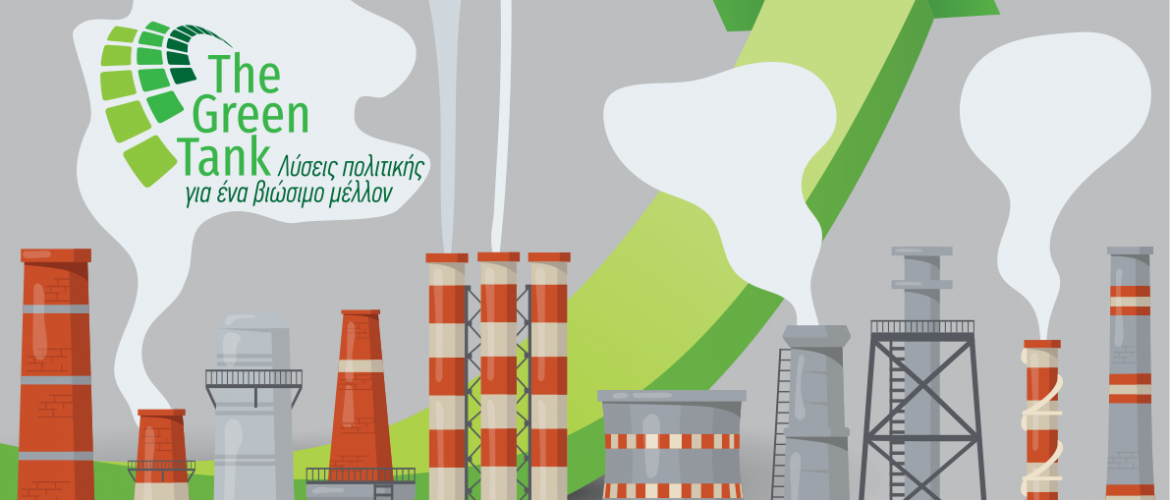Greece holds the third best EU climate performance in the sectors covered by the Emissions Trading System (ETS) according to a new analysis by the Green Tank – Drastic decline in lignite production plays crucial role – Industry emissions remain stable
As Europe is preparing to revise the EU-ETS Directive in the framework of the “fit for 55” legislative package, the Green Tank examines what has happened since the launch of the European Union’s Emissions Trading System (EU ETS) in 2005 to date, in its new analysis titled “Trends in the Emissions Trading System in the EU and in Greece”.
Based on official data from the European Commission and the European Environment Agency, the study analyzed changes in greenhouse gas (GHG) emissions in the electricity and heat production, industry and aviation sectors during the three phases of the EU-ETS (2005-2020) at the EU-27 and national levels, focusing on Greece.
The results of the analysis for the first 15 years of the ETS operation demonstrates the effectiveness of the tool in reducing GHG emissions, which could have been even greater had so many free allowances not been granted to Europe’s energy-intensive industry.
More specifically, the data analysis at the EU level shows that:
- ETS emissions in the EU decreased by 42.3% from 2005 to 2020, slightly below the target previously set for 2030 (-43%), highlighting the low ambition shown by the EU a few years ago, as well as, the potential that the EU-ETS has to contribute to climate progress.
- The overall emissions reduction occurred mainly due to the decline in emissions in the electricity & heat generation sector, and particularly from lignite and coal, while industry emissions remained relatively stable throughout the 15 year period, due to the large number of free allowances granted to the sector.
- The last year examined – 2020 – constitutes an exception to these trends, as in addition to the electricity and power sectors, significant emissions reductions are noted also from the industry and aviation sectors, due to the pandemic.
With respect to Greece:
- Greece had the 3rd best performance among the EU-27 attaining reductions in the ETS sectors of 56.3% in 2020 compared to 2005. Only Denmark (-58.3%) and Estonia (-56.4%) performed marginally better.
- This reduction in Greek ETS emissions is largely due to the decline, particularly in the last two years, in lignite-based electricity generation, which in 2020 emitted 14 million fewer tonnes of CO2 compared to 2018. Hence, Greece noted the greatest percentage reduction of emissions from solid fossil fuels among the EU coal and lignite producing countries compared to 2005 (-78.9%).
- However, this reduction of emissions from lignite was followed by an increase in emissions from fossil gas (+44% in 2020 compared to 2013), as well as the presence of fossil gas units among Greece’s 10 biggest emitters in 2020, the first time since the start of the 3rd EU-ETS phase in 2013.
- Also, 2020 was the first year, when emissions from the energy-intensive industry (11.5 million tonnes) surpassed those from lignite (9.2 million tonnes).
«Phasing out lignite places Greece in a climate leadership position. However, for this climate progress to be solidified, Greece must reduce its use of fossil gas and clearly support the green shift of its energy-intensive industry. During the upcoming EU-ETS Directive revision, brave reforms that will contribute decisively to the reduction of net greenhouse gas emissions by at least 55% by 2030 compared to 1990, not only at the EU, but also at the national level, are needed”, noted Nikos Mantzaris, Senior Policy Analyst of the Green Tank.
Notes:
- You can read the full text of the Green Tank report in English “Trends in the Emissions Trading System in the EU and in Greece“.
- An overview of the report is available here: 2005-2020: Analyzing the carbon market in the EU and Greece




















































































































































































































































































































